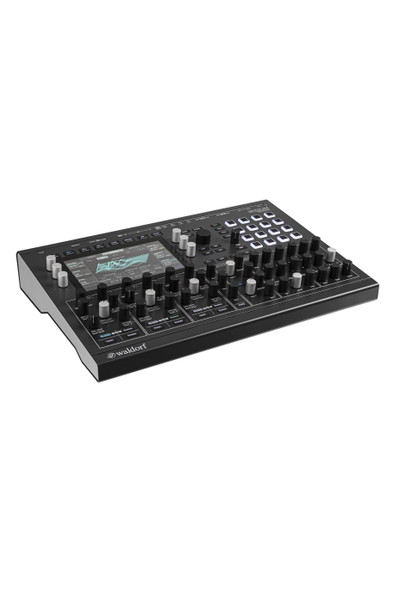Description
Waldorf M Classic Hybrid Wavetable Synthesizer with Analog Filters
Sound designers and synthesizer aficionados will rejoice over the Waldorf M, a four-part, eight-voice hybrid wavetable synthesizer that hails back to the original Microwave synthesizer—complete with analog filters.
The dual oscillator synthesizer features classic Microwave and modern Microwave II/XT sound generation modes with a total of 2048 patches, broken up into 16 banks of 128 sounds. Each sound set was produced by renown sound designers and includes the classic Microwave sound sets, such as MW1 Factory Sound Set, MW1 Soundpool 1-5, the fat-sounding Analogue and Bassco, as well as PPG Wave 2.3 sounds cleverly converted for the original Microwave. The M features an analog lowpass 24 dB/Oct voltage-controlled filter (VCF is the SSI 2144 improved ladder type) with resonance and analog saturation, as well as a true stereo analogue VCA with panning options. Modulation is available from four advanced envelope generators and two LFOs.
The rear panel features a 1/4" stereo headphone output, two 1/4" stereo main outputs, plus four 1/4" aux outputs. The full-sized 5-pin DIN MIDI connectors provide in, out, and thru. Additionally, the instrument features USB MIDI from the Type-B connector that works directly with your computer. An SD-card slot is available for system upgrades and backups of all your favorite patches.
At a Glance
- Oscillators: 2 wavetable oscillators with independent wavetables and two different tone generation models—classic Waldorf Microwave I model and modern Waldorf Microwave II model. There are 96 Factory Wavetables + 32 slots for User Wavetables
- Filter: Analog low-pass 24 dB/oct VCF (SSI 2144 improved ladder type) with saturation
- Amplifier: Analog stereo VCA for each voice
- Envelopes: 4 envelope generators; 8 point loopable time/level wave envelope generator, VCF and VCA ADSR envelopes and a free assignable loopable 4 points time/level envelope
- LFOs: 2 LFOs with different waveforms
- Arpeggiator with 16 preset patterns, chord mode and the ability to synchronize to MIDI clock
- Sound storage: 2048 Sound programs + 128 Multi programs
- Polyphony: 8/16 voices polyphony (16 voices available with the expansion board installed)
- Multitimbrality: 4 parts, which can be assigned to 4 individual stereo outputs
- MIDI: USB 2.0 and DIN (5-pin DIN connector with in/out/thru)
- Compatible with classic Waldorf Microwave I sysex messages (sound bank transfer / sound transfer)
- SD card for loading / storing user content as soundbanks and wavetables
Wavetable Oscillator Section
This principle offers powerful capabilities. To give some examples:
- The wave envelope can modulate the position within the wavetable.
- Each note on a keyboard can access a different wave of a wavetable.
- An LFO can modulate the position within the wavetable. You can create subtle to drastic sound changes.
- User-selected controllers, such as the Mod wheel, can change the position within the wavetable. When you turn the wheel while playing a chord, each note’s wave will be modified instantly.
Oscillator Mixer (Mix) Section
In the Oscillator Mixer section, you control the volumes of both oscillators and the Noise generator. If an oscillator volume dial is turned fully counterclockwise, no signal is passed. The Ring Modulator is available, if the Modern Microwave II mode is active.
VCF Section
VCA Section
Envelopes Section
- VCF Envelope: This envelope is designed to control the VCF but can also be used for other modulations.
- VCA Envelope: This envelope is designed to control the sound volume but can also be used for other modulations.
- Wave Envelope: This envelope with 8 different times and levels (multisegment envelope) is designed to control the wave scanning for a wavetable, but can also be used for other modulations.
- Free Envelope: This envelope with 4 different times and levels (multisegment envelope) can be used freely to perform additional modulations on any module.
An envelope is started by pressing a key. It ascends to its maximum value at the rate determined by the Attack parameter. It then descends at the rate determined by the Decay value until it reaches the predetermined Sustain value. It remains at this value until the key is released. The envelope then descends to zero at the rate determined by the Release parameter.
LFO Section
The Modulation Assignment
The Arpeggiator
Delivery & Returns
At Gear Club Direct, we want you to be happy with your purchase. We understand that there are times when once a product is received, it may not be what you needed or wanted after all. So, we will gladly accept your qualifying return within 15 days of the delivery date. After 15 days of the delivery date, all sales are final.
The Return Process
Customers are required to obtain a Pre-Authorization to return any product. To submit a request for a return, simply log in to your account and request a return and one of our sales representatives will contact you within 24-48 business hours. If you do not have an account with us, please open a help ticket, providing as much detail as possible and whether you are requesting a refund or an exchange. READ MORE
 Text Us +1 773-430-6136
Text Us +1 773-430-6136





























